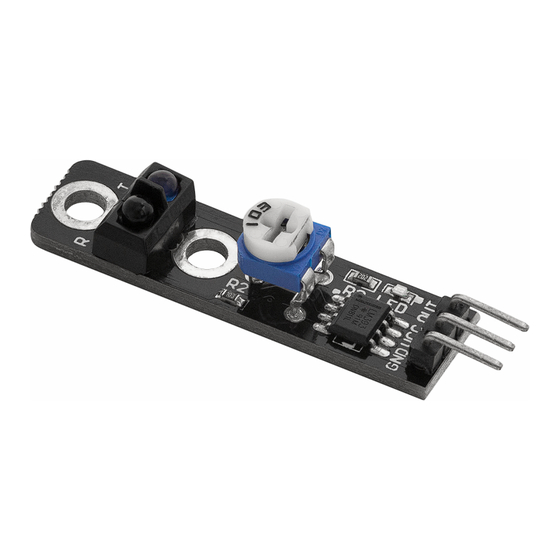
Summary of Contents for AZ-Delivery KY-033
- Page 1 Welcome! Thank you for purchasing our AZ-Delivery KY-033 Line-tracker Sensor Module. On the following pages, you will be introduced to how to use and set up this handy device. Have fun!
- Page 2 Areas of application Education and teaching: Use in schools, universities and training institutions to teach the basics of electronics, programming and embedded systems. Research and development: Use in research and development projects to create prototypes and experiments in the fields of electronics and computer science. Prototype development: Use in the development and testing of new electronic circuits and devices.
- Page 3 consult a doctor. Caution: Keep the product out of the reach of children and pets to avoid accidental contact and swallowing of small parts. Note: Store the product in a safe, closed container when not in use. Attention: Avoid contact of the product with food and drinks.
-
Page 4: Table Of Contents
Table of Contents Introduction......................3 Specifications....................4 The pinout......................5 How to set-up Arduino IDE................6 How to set-up the Raspberry Pi and Python..........10 Connecting the module with Atmega328p............11 Sketch example..................12 Connecting the module with Raspberry Pi.............14 Python script....................15 - 2 -... -
Page 5: Introduction
Introduction The KY-033 line-tracker sensor module uses an infrared transmitter and receiver that detects how reflective the surface is. On-board the KY-033 module there are the LM393 dual analog voltage comparator chip, a potentiometer, a status LED, two resistors and TCRT5000 infrared transmitter and receiver. -
Page 6: Specifications
Specifications » Operating voltage range: from 3.3V to 5V DC » Working current: ~20mA » Detection distance: from 5mm to 150mm » Detection angle: 35° » Dimensions: 42 x 11mm [1.65 x 0.4in] The transmittting part of the TCRT5000 emits infrared light at a certain frequency, light bounce back from the surface and gets detected by an infrared light detector. -
Page 7: The Pinout
The pinout The KY-033 line-tracker sensor module has three pins. The pinout diagram is shown on the following image: - 5 -... -
Page 8: How To Set-Up Arduino Ide
How to set-up Arduino IDE If the Arduino IDE is not installed, follow the link and download the installation file for the operating system of choice. For Windows users, double click on the downloaded .exe file and follow the instructions in the installation window. - 6 -... - Page 9 For Linux users, download a file with the extension .tar.xz, which has to be extracted. When it is extracted, go to the extracted directory and open the terminal in that directory. Two .sh scripts have to be executed, the first called arduino-linux-setup.sh and the second called install.sh.
- Page 10 Almost all operating systems come with a text editor preinstalled (for example, Windows comes with Notepad, Linux Ubuntu comes with Gedit, Linux Raspbian comes with Leafpad, etc.). All of these text editors are perfectly fine for the purpose of the eBook. Next thing is to check if your PC can detect an Atmega328p board.
- Page 11 If the Arduino IDE is used on Windows, port names are as follows: For Linux users, for example port name is /dev/ttyUSBx, where x represents integer number between 0 and 9. - 9 -...
-
Page 12: How To Set-Up The Raspberry Pi And Python
How to set-up the Raspberry Pi and Python For the Raspberry Pi, first the operating system has to be installed, then everything has to be set-up so that it can be used in the Headless mode. The Headless mode enables remote connection to the Raspberry Pi, without the need for a PC screen Monitor, mouse or keyboard. -
Page 13: Connecting The Module With Atmega328P
Connecting the module with Atmega328p Connect the KY-033 module with the Atmega328p as shown on the following connection diagram: KY-033 pin > Mc pin > Blue wire > Black wire > Red wire - 11 -... -
Page 14: Sketch Example
Sketch example #define OUT_PIN 2 void setup() { Serial.begin(9600); pinMode(OUT_PIN, INPUT); void loop() { Serial.println(digitalRead(OUT_PIN)); delay(1000); - 12 -... - Page 15 Upload the sketch to the Atmega328p and open Serial Monitor (Tools > Serial Monitor). The result should look like the output on the following image: - 13 -...
-
Page 16: Connecting The Module With Raspberry Pi
Connecting the module with Raspberry Pi Connect the KY-033 module with the Raspberry Pi as shown on the following connection diagram: KY-033 pin > Raspberry Pi pin > [pin 14] Black wire > GPIO22 [pin 15] Blue wire > [pin 17]... -
Page 17: Python Script
Python script import RPi.GPIO GPIO from time import sleep GPIO.setmode(GPIO.BCM) GPIO.setwarnings(False) # Pin setup for the module Signal_PIN GPIO.setup(Signal_PIN, GPIO.IN) print('[Press CTRL + C to end the script!]') try: # Main program loop while True: GPIO.input(Signal_PIN): print('Line detected') else: print('No line') sleep(1) # Wait for a second... - Page 18 Save the script by name lineTracker.py. To run the script open terminal in the directory where the script is saved and run the following command: python3 lineTracker.py The result should look like the output on the following image: To end the script press CTRL + C on the keyboard. - 16 -...
- Page 19 If you are looking for the high quality microelectronics and accessories, AZ-Delivery Vertriebs GmbH is the right company to get them from. You will be provided with numerous application examples, full installation guides, eBooks, libraries and assistance from our technical experts.







Need help?
Do you have a question about the KY-033 and is the answer not in the manual?
Questions and answers